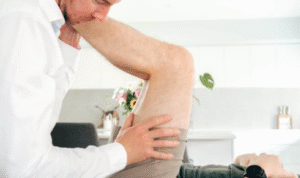
Hamstring injuries are among the most common muscle strains, particularly in athletes, runners, and active individuals. A hamstring strain occurs when one or more of the muscles at the back of the thigh are overstretched or torn. This condition can range from mild discomfort to severe pain that limits movement and mobility. Early intervention and the right approach to recovery play a significant role in restoring muscle function and preventing long-term issues. In this article, we’ll explore effective hamstring strain treatment options and how professional rehabilitation support, like that offered by Northwest Rehab Group, can help.
Understanding Hamstring Strains
The hamstrings are a group of three muscles – the semitendinosus, semimembranosus, and biceps femoris – that run along the back of your thigh. They are responsible for bending the knee and extending the hip, both of which are crucial for walking, running, and jumping. A strain often happens due to:
-
Sudden acceleration or sprinting
-
Insufficient warm-up before activity
-
Muscle fatigue
-
Previous hamstring injuries
-
Imbalances between the quadriceps and hamstrings
Depending on severity, hamstring strains are categorized into three grades:
-
Grade 1: Mild strain with minimal tearing and discomfort.
-
Grade 2: Moderate tear causing pain, swelling, and difficulty moving.
-
Grade 3: Severe tear or complete rupture, often requiring surgical attention.
Key Symptoms of Hamstring Strain
Common signs of a hamstring injury include:
-
Sudden sharp pain at the back of the thigh
-
Swelling and bruising within hours
-
Weakness and reduced range of motion
-
Difficulty walking, running, or sitting comfortably
Recognizing these symptoms early can help you seek appropriate treatment before the condition worsens.
Immediate First Aid for Hamstring Strains
If you suspect a hamstring strain, initial first aid steps can reduce pain and inflammation:
-
Rest: Avoid putting weight on the injured leg and stop any activity that worsens pain.
-
Ice: Apply ice packs for 15–20 minutes every few hours during the first 48 hours.
-
Compression: Use a bandage or wrap to minimize swelling.
-
Elevation: Raise the injured leg above heart level to reduce fluid buildup.
These steps, known as the RICE method, are effective during the first phase of injury management.
Professional Hamstring Strain Treatment
While home remedies help in the short term, a structured rehabilitation program is essential for complete recovery. This is where expert care from clinics like Northwest Rehab Group plays a vital role. Their team of chiropractors and physiotherapists creates customized treatment plans designed to restore strength, flexibility, and mobility.
Professional treatment may include:
-
Manual therapy: Hands-on techniques to reduce muscle tension and improve circulation.
-
Targeted exercises: Stretching and strengthening programs tailored to the stage of healing.
-
Soft tissue therapy: Techniques like massage and myofascial release to ease tightness.
-
Electrotherapy and ultrasound: Methods to reduce inflammation and speed up healing.
-
Education: Guidance on posture, warm-ups, and injury prevention strategies.
Importance of Rehabilitation
Many individuals make the mistake of returning to activity too soon after a hamstring injury. Without proper rehabilitation, the risk of re-injury increases significantly. A guided program ensures muscles heal correctly, regaining both strength and flexibility. Rehabilitation also addresses underlying issues like muscle imbalances or poor biomechanics that may have contributed to the injury in the first place.
Preventing Future Hamstring Strains
Prevention is just as important as treatment. Some effective preventive measures include:
-
Performing dynamic stretches before activity and static stretches afterward
-
Incorporating hamstring-strengthening exercises into workouts
-
Balancing training between the hamstrings and quadriceps
-
Allowing adequate rest and recovery between intense activities
-
Gradually increasing intensity rather than making sudden changes in activity levels
Conclusion
Hamstring strains can be painful and disruptive, but with proper care, recovery is achievable. Initial self-care combined with professional treatment ensures long-term results and reduces the chance of recurrence. By seeking expert guidance, you not only heal effectively but also learn techniques to prevent future injuries. Clinics like Northwest Rehab Group provide comprehensive, evidence-based treatment plans to help you return to your daily activities stronger and healthier.
